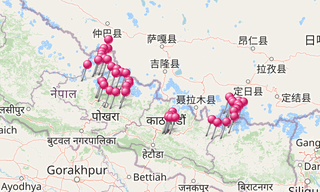Annapurna is a section of the Himalayas in north-central Nepal that includes 8,091 m Annapurna I, thirteen additional peaks over 7,000 m and 16 more over 6,000 m. This section is a 55 km long massif bounded by the Kali Gandaki Gorge on the west, the Marshyangdi River on the north and east, and Pokhara Valley on the south.
Annapurna I is tenth among Earth’s fourteen eight-thousanders. 8167 m Dhaulagiri I rises 34 km to the west across the Kali Gandaki Gorge, considered Earth’s deepest canyon. Annapurna is a Sanskrit name which literally means “full of food”, but is normally translated as “Goddess of the Harvests”.
The entire massif and surrounding area are protected within the 7,629 km² Annapurna Conservation Area, the first and largest conservation area in Nepal. The Annapurna Conservation Area is home to several world-class treks, including the Annapurna Circuit. The Annapurna peaks are among the world’s most dangerous mountains to climb, although in more recent history, using figures from only 1990 and after, Kangchenjunga has a higher fatality rate.
Annapurna I was the first 8,000 m peak to be climbed. Maurice Herzog and Louis Lachenal, of a French expedition led by Maurice Herzog (including Lionel Terray, Gaston Rébuffat, Marcel Ichac, Jean Couzy, Marcel Schatz, Jacques Oudot, Francis de Noyelle), reached the summit on 3rd of June 1950.
Main sights
Annapurna I, Bagarchhap, Bagnunpani, Begnas, Bahundanda, Begnas, Chame, Dhampus, Ghandruk, Khudi, Landruk, Machapuchare, Manang, Manaslu, Muktinath, Nalma, Pisang, Pokhara, Syanje, Tatopani, Thorong La
Eight Thousanders
Everest (8,848 m), K2 (8,611 m), Kangchenjunga (8,586 m), Lhotse (8,516 m), Makalu (8,463 m), Cho Oyu (8,201 m), Dhaulagiri (8,167 m), Manaslu (8,163 m), Nanga Parbat (8,126 m), Annapurna (8,091 m), Gasherbrum I (8,068 m), Broad Peak (8,047 m), Gasherbrum II (8,035 m), Shishapangma (8,027 m)

-Ghandruk.hero.landscape.jpg)

.jpg?w=256)
-Dhaulagiri.jpg?w=256)
-Gyaru.jpg?w=256)
-Landruk.jpg?w=256)
-Bahundanda.jpg?w=256)
-Khudi.jpg?w=256)
-Jharkot.jpg?w=256)
-Dhampus.jpg?w=256)
-Muktinath.jpg?w=256)
-Annapurna-II.jpg?w=256)
-Chulu.jpg?w=256)
-Annapurna-II.jpg?w=256)
-Syamje.jpg?w=256)
-Nawal.jpg?w=256)
.jpg?w=256)
-Landruk.jpg?w=256)
-Kagbeni.jpg?w=256)
-Muktinath.jpg?w=256)
.jpg?w=256)
-Kalopani.jpg?w=256)
-Annapurna-II-and-III.jpg?w=256)
-Jomsom.jpg?w=256)
-Gyaru.jpg?w=256)
-Syamje.jpg?w=256)
.jpg?w=256)
-Braga.jpg?w=256)
-Gyaru.jpg?w=256)
.jpg?w=256)
-Annapurna-II.jpg?w=256)
-Dhaulagiri.jpg?w=256)
-Nawal.jpg?w=256)
.jpg?w=256)
-Pokhara.jpg?w=256)
.jpg?w=256)
-Kalopani.jpg?w=256)
-Braga.jpg?w=256)
-Braga.jpg?w=256)
.jpg?w=256)
-Jomsom.jpg?w=256)
-Khudi.jpg?w=256)
-Landruk.jpg?w=256)
-Braga.jpg?w=256)
-Annapurna-II.jpg?w=256)
-Annapurna-II.jpg?w=256)
.jpg?w=256)
.jpg?w=256)
.jpg?w=256)
-Dhampus.jpg?w=256)
-Tengboche-(3860m).hero.jpg?w=320)

-Gyachung-Kang-(7952m).hero.jpg?w=320)

.hero.jpg?w=320)
.map.png)
-Jharkot.jpg?w=256)
-Nilgiri.jpg?w=256)
-Braga.jpg?w=256)
-Ghandruk.jpg?w=256)
.jpg?w=256)
-Braga.jpg?w=256)
-Muktinath.jpg?w=256)
-Gyaru.jpg?w=256)
-Landruk.jpg?w=256)
-Nilgiri.jpg?w=256)
.jpg?w=256)
-Tukche.jpg?w=256)
-Tatopani.jpg?w=256)
.jpg?w=256)
-Dhampus.jpg?w=256)
-Muktinath.jpg?w=256)
-Annapurna-I.jpg?w=256)
.jpg?w=256)
-Braga.jpg?w=256)
.jpg?w=256)
.jpg?w=256)
-Tatopani.jpg?w=256)
-Tatopani.jpg?w=256)
-Nalma.jpg?w=256)
.jpg?w=256)
-Muktinath.jpg?w=256)
-Gangapurna.jpg?w=256)
-Muktinath.jpg?w=256)
-Annapurna-III.jpg?w=256)
-Dhampus.jpg?w=256)
-Jharkot.jpg?w=256)
-Jomsom.jpg?w=256)
-Annapurna-III.jpg?w=256)
-Ghandruk.jpg?w=256)
.jpg?w=256)
-Manaslu.jpg?w=256)
-Bahundanda.jpg?w=256)
-Begnas.jpg?w=256)
-Jharkot.jpg?w=256)
.jpg?w=256)
.jpg?w=256)
.jpg?w=256)
-Kagbeni.jpg?w=256)
-Gyaru.jpg?w=256)
-Muktinath.jpg?w=256)
-Annapurna-II.jpg?w=256)
.jpg?w=256)
-Chame.jpg?w=256)
-Annapurna-II.jpg?w=256)
-Annapurna-I.jpg?w=256)
.jpg?w=256)
-Braga.jpg?w=256)
-Manang.jpg?w=256)
-Nilgiri.jpg?w=256)
-Chitre.jpg?w=256)
.jpg?w=256)
-Annapurna-I.jpg?w=256)
.jpg?w=256)
.jpg?w=256)
-Annapurna-II-and-III.jpg?w=256)
.jpg?w=256)
-Nilgiri.jpg?w=256)
-Baglunpani.jpg?w=256)
-Begnas.jpg?w=256)
-Tukche.jpg?w=256)
-Manaslu.jpg?w=256)
-Gyaru.jpg?w=256)
-Bahundanda.jpg?w=256)
-Pisang.jpg?w=256)
.jpg?w=256)
-Chulu.jpg?w=256)
.jpg?w=256)
-Bagarchhap.jpg?w=256)
.jpg?w=256)
-Jomsom.jpg?w=256)
-Chitre.jpg?w=256)
-Ghandruk.jpg?w=256)
-Nalma.jpg?w=256)
.jpg?w=256)
.jpg?w=256)
.jpg?w=256)
.jpg?w=256)
-Pisang.jpg?w=256)
-Gyaru.jpg?w=256)
-Dhampus.jpg?w=256)
-Thorong-La.jpg?w=256)
-Baglunpani.jpg?w=256)
-Landruk.jpg?w=256)
.jpg?w=256)
-Nilgiri.jpg?w=256)
.jpg?w=256)
-Tukche.jpg?w=256)
-Pisang.jpg?w=256)
-Kalopani.jpg?w=256)
-Dhaulagiri.jpg?w=256)
-Annapurna-Sud.jpg?w=256)
.jpg?w=256)
.jpg?w=256)
.jpg?w=256)
-Braga.jpg?w=256)
-Braga.jpg?w=256)
-Kagbeni.jpg?w=256)
.jpg?w=256)
-Muktinath.jpg?w=256)
-Pisang.jpg?w=256)
-Gyaru.jpg?w=256)
.jpg?w=256)
-Kagbeni.jpg?w=256)
-Manaslu.jpg?w=256)
-Tatopani.jpg?w=256)
.jpg?w=256)
-Tukche-Peak.jpg?w=256)
-Baglunpani.jpg?w=256)
-Khudi.jpg?w=256)
-Gangapurna.jpg?w=256)
.jpg?w=256)
-Gyaru.jpg?w=256)
.jpg?w=256)
-Annapurna-I.jpg?w=256)
.jpg?w=256)
-Bahundanda.jpg?w=256)
-Pisang.jpg?w=256)
.jpg?w=256)
-Jomsom.jpg?w=256)
.jpg?w=256)
-Manaslu.jpg?w=256)
.jpg?w=256)
-Pisang.jpg?w=256)
.jpg?w=256)
-Manang.jpg?w=256)
-Chame.jpg?w=256)
-Pisang.jpg?w=256)
-Gyaru.jpg?w=256)
.jpg?w=256)
-Jharkot.jpg?w=256)
.jpg?w=256)
-Dana.jpg?w=256)
-Ghandruk.jpg?w=256)
-Pisang.jpg?w=256)
.jpg?w=256)
-Muktinath.jpg?w=256)
.jpg?w=256)
-Ghandruk.jpg?w=256)
.jpg?w=256)
-Anapurna-II.jpg?w=256)
-Bahundanda.jpg?w=256)
.jpg?w=256)
.jpg?w=256)
.jpg?w=256)
.jpg?w=256)
-Pisang.jpg?w=256)
-Dhaulagiri.jpg?w=256)
.jpg?w=256)
-Baglunpani.jpg?w=256)
-Baglunpani.jpg?w=256)
.jpg?w=256)
.jpg?w=256)
.jpg?w=256)
.jpg?w=256)
-Nawal.jpg?w=256)
-Pisang.jpg?w=256)
-Muktinath.jpg?w=256)
-Kalopani.jpg?w=256)
.jpg?w=256)
-Ghandruk.jpg?w=256)
.jpg?w=256)
-Nilgiri.jpg?w=256)
-Kalopani.jpg?w=256)
.jpg?w=256)
.jpg?w=256)
-Gyaru.jpg?w=256)
-Tukche.jpg?w=256)
.jpg?w=256)
-Braga.jpg?w=256)
-Kalopani.jpg?w=256)
-Dhampus.jpg?w=256)
-Landruk.jpg?w=256)
-Lete.jpg?w=256)
-Machapuchre.jpg?w=256)
.jpg?w=256)
-Pisang-Peak.jpg?w=256)
.jpg?w=256)
-Dana.jpg?w=256)
-Nawal.jpg?w=256)
.jpg?w=256)
-Manaslu.jpg?w=256)
-Manang.jpg?w=256)
.jpg?w=256)
-Ghandruk.jpg?w=256)
-Braga.jpg?w=256)
.jpg?w=256)
-Tatopani.jpg?w=256)
-Tukche.jpg?w=256)
.jpg?w=256)
-Dhampus.jpg?w=256)
.jpg?w=256)
-Nalma.jpg?w=256)
.jpg?w=256)
-Bagarchhap.jpg?w=256)
-Nilgiri.jpg?w=256)
.jpg?w=256)
-Gyaru.jpg?w=256)
-Pokhara.jpg?w=256)
-Annapurna-III.jpg?w=256)
-Dhampus.jpg?w=256)
-Bahundanda.jpg?w=256)
-Pisang.jpg?w=256)
-Pisang.jpg?w=256)
-Dhampus.jpg?w=256)
-Dhampus.jpg?w=256)
.jpg?w=256)
-Manaslu.jpg?w=256)
-Muktinath.jpg?w=256)
-Annapurna-I.jpg?w=256)